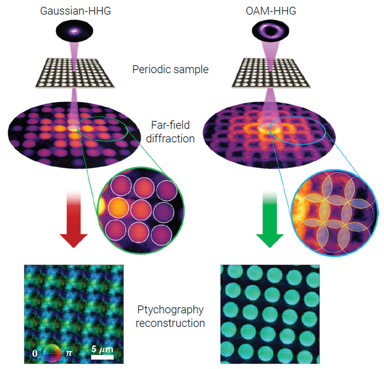 [Enlarge image]EUV ptychographic microscope using OAM and Gaussian high-harmonic generation (HHG) EUV beams for imaging highly periodic structures. A comparison of image quality for a highly periodic sample for Gaussian and OAM illumination reveals that only OAM-illumination ptychography results in a successful reconstruction. The amplitude and phase are plotted as brightness and hue, respectively.
[Enlarge image]EUV ptychographic microscope using OAM and Gaussian high-harmonic generation (HHG) EUV beams for imaging highly periodic structures. A comparison of image quality for a highly periodic sample for Gaussian and OAM illumination reveals that only OAM-illumination ptychography results in a successful reconstruction. The amplitude and phase are plotted as brightness and hue, respectively.
Lensless imaging based on ptychographic coherent diffractive imaging enables diffraction-limited microscopy at short wavelengths, overcoming the limits of imperfect optics.1,2 Ptychographic imaging of highly periodic structures has been challenging, however, due to the lack of diversity in the recorded diffraction patterns, which leads to poor convergence of the reconstructed sample images. Although techniques (such as modulus enforced probe and total variation regularization) have been explored to address this challenge, they suffer from slow convergence, heavy reliance on constraints on the samples, or both. This significantly limits ptychography’s application to a wide variety of periodic structures in photonics, nanoelectronics and extreme ultraviolet (EUV) photomasks.
In recently published work, we demonstrated a solution to the long-standing challenge of ptychographic imaging of highly-periodic structures, by taking advantage of high-harmonic beams carrying orbital angular momentum (OAM).3 The key idea is that the increased divergence of the OAM high-harmonic beams, combined with the ring-shaped intensity distribution, introduces strong interference fringes between adjacent diffraction orders in the far field. These encode phase information into measurable intensity modulation in diffraction fields, significantly enhancing diversity in the recorded diffraction patterns so that the phase can be reliably retrieved.
In our experiments, an OAM high-harmonic EUV beam was generated and used to illuminate a 2D periodic sample. The complex-valued sample image was then ptychographically reconstructed, and the recovered image exhibited far higher fidelity than with Gaussian illumination. Moreover, we showed that the method can sensitively and nondestructively detect defects in otherwise periodic grids with an improvement of more than two orders of magnitude in signal-to-noise ratio.
Researchers
Bin Wang,* Nathan J. Brooks,* Peter Johnsen, Nicholas W. Jenkins, Yuka Esashi, Iona Binnie, Michael Tanksalvala and Margaret M. Murnane, JILA, University of Colorado, Boulder, CO, USA
Henry C. Kapteyn, JILA, University of Colorado, and KMLabs Inc., Boulder, CO, USA
*These authors contributed equally.
References
1. J.M. Rodenburg et al. Phys. Rev. Lett. 98, 034801 (2007).
2. P. Thibault et al. Science 321, 379 (2008).
3. B. Wang et al. Optica 10, 1245 (2023).
